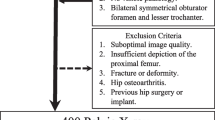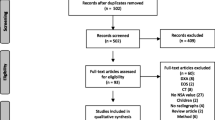Abstract
Introduction
Variations in osseous, neural and muscular anatomical structures in the gluteal region have been investigated for their role in causing deep gluteal pain syndromes including piriformis syndrome. This study aimed to radiologically determine whether the femoral neck–shaft angle (NSA) in piriformis syndrome differs from that in a healthy population.
Methods
Two groups of participants comprising 23 piriformis syndrome patients and 22 healthy controls were included in the present study. Piriformis syndrome was diagnosed based on clinical findings and the diagnosis was confirmed by intramuscular local anaesthetic injection. Femoral NSAs were measured from the anteroposterior pelvic radiographs and compared between the control and piriformis syndrome-affected groups.
Results
The age, height, body weight, body mass index and gender distribution differences between the two groups (control and piriformis) were not statistically significant. The femur NSA was significantly lower in the piriformis group than in the control group. The receiver operating characteristic analysis revealed that the area under the curve, sensitivity and specificity for predicting the risk of piriformis syndrome (PS) were 0.946%, 100% and 86.36%, respectively, at an NSA cut-off of 127°.
Conclusions
Reduced femoral NSA is related to PS. However, studies with a larger study sample are needed to further substantiate this finding.




Similar content being viewed by others
References
Hernando, M. F., Cerezal, L., Pérez-Carro, L., Abascal, F., & Canga, A. (2015). Deep gluteal syndrome: Anatomy, imaging, and management of sciatic nerve entrapments in the subgluteal space. Skeletal Radiology, 44(7), 919–934.
Park, J. W., Lee, Y. K., Lee, Y. J., Shin, S., Kang, Y., & Koo, K. H. (2020). Deep gluteal syndrome as a cause of posterior hip pain and sciatica-like pain. The Bone & Joint Journal, 102B(5), 556–567.
Kizaki, K., Uchida, S., Shanmugaraj, A., Aquino, C. C., Duong, A., Simunovic, N., Martin, H. D., & Ayeni, O. R. (2020). Deep gluteal syndrome is defined as a non-discogenic sciatic nerve disorder with entrapment in the deep gluteal space: A systematic review. Knee Surgery, Sports Traumatology, Arthroscopy, 28(10), 3354–3364.
Chang, A., Ly, N., & Varacallo, M. (2022). Piriformis injection. In StatPearls. StatPearls Publishing. Available from: https://www.ncbi.nlm.nih.gov/books/NBK448193/.
Jankovic, D., Peng, P., & van Zundert, A. (2013). Brief review: Piriformis syndrome: Etiology, diagnosis, and management. Canadian Journal of Anaesthesia, 60(10), 1003–1012.
Hicks, B. L., Lam, J. C., & Varacallo, M. (2022). Piriformis syndrome. In StatPearls. StatPearls Publishing. Available from: https://www.ncbi.nlm.nih.gov/books/NBK448172/ Accessed 15 Jan 22
Michel, F., Decavel, P., Toussirot, E., Tatu, L., Aleton, E., Monnier, G., Garbuio, P., & Parratte, B. (2013). The piriformis muscle syndrome: An exploration of anatomical context, pathophysiological hypotheses and diagnostic criteria. Annals of Physical and Rehabilitation Medicine, 56(4), 300–311.
Haładaj, R., Pingot, M., Polguj, M., Wysiadecki, G., & Topol, M. (2015). Anthropometric study of the piriformis muscle and sciatic nerve: A morphological analysis in a Polish population. Medical Science Monitor, 21, 3760–3768.
Hintze, J.L. (2011). PASS 11. NCSS, LLC. Kaysville, Utah, USA. www.ncss.com Accessed 9 Aug 2021.
Probst, D., Stout, A., & Hunt, D. (2019). Piriformis syndrome: A narrative review of the anatomy, diagnosis, and treatment. PM & R, 11(1), 54–63.
Freiberg, A. H., & Vinke, T. H. (1934). Sciatica and the sacro-iliac joint. Journal of Bone and Joint Surgery., 16(1), 126–136.
Solheim, L. F., Siewers, P., & Paus, B. (1981). The piriformis muscle syndrome. Sciatic nerve entrapment treated with section of the piriformis muscle. Acta Orthopaedica Scandinavica, 52(1), 73–75.
Beatty, R. A. (1994). The piriformis muscle syndrome: A simple diagnostic maneuver. Neurosurgery, 34(3), 512–514.
Palamar, D., & Akgun, K. (2019). Pelvic ınjections. In L. Ozcakar, K. V. Chang, E. Gürçay, G. Park, F. Franchignomi, & V. Ricci (Eds.), Ultrasound imaging and guidance for musculoskeletal interventions in physical and rehabilitation medicine (pp. 287–289). Milan: Edi Ermes.
Misirlioglu, T. O., Akgun, K., Palamar, D., Erden, M. G., & Erbilir, T. (2015). Piriformis syndrome: Comparison of the effectiveness of local anesthetic and corticosteroid injections: A double-blinded, randomized controlled study. Pain Physician, 18(2), 163–171.
Fischer, C. S., Kühn, J. P., Völzke, H., Ittermann, T., Gümbel, D., Kasch, R., Haralambiev, L., Laqua, R., Hinz, P., & Lange, J. (2020). The Neck–Shaft angle: An update on reference values and associated factors. Acta Orthopaedica, 91(1), 53–57.
Hanley, J. A., & McNeil, B. J. (1982). The meaning and use of the area under a receiver operating characteristic (ROC) curve. Radiology, 143(1), 29–36.
Hopayian, K., & Danielyan, A. (2018). Four symptoms define the piriformis syndrome: An updated systematic review of its clinical features. European Journal of Orthopaedic Surgery & Traumatology, 28(2), 155–164.
Parziale, J. R., Hudgins, T. H., & Fishman, L. M. (1996). The piriformis syndrome. American Journal of Orthopedics, 25(12), 819–823.
Hopayian, K., Song, F., Riera, R., & Sambandan, S. (2010). The clinical features of the piriformis syndrome: A systematic review. European Spine Journal, 19(12), 2095–2109.
Benzon, H. T., Katz, J. A., Benzon, H. A., & Iqbal, M. S. (2003). Piriformis syndrome: Anatomic considerations, a new injection technique, and a review of the literature. Anesthesiology, 98(6), 1442–1448.
Barbosa, A., Santos, P., Targino, V. A., Silva, N. A., Silva, Y., Gomes, F. B., & Assis, T. O. (2019). Sciatic nerve and its variations: Is it possible to associate them with piriformis syndrome? Arquivos de Neuro-Psiquiatria, 77(9), 646–653.
Poutoglidou, F., Piagkou, M., Totlis, T., Tzika, M., & Natsis, K. (2020). Sciatic nerve variants and the piriformis muscle: A systematic review and meta-analysis. Cureus, 12(11), e11531.
Leite, M. J., Pinho, A. R., Silva, M. R., Lixa, J. C., Maderia, M. D., & Pereira, P. G. (2020). Deep gluteal space anatomy and its relationship with deep gluteal pain syndromes. Hip International, 32, 1120700020966255.
Fearon, A., Stephens, S., Cook, J., Smith, P., Neeman, T., Cormick, W., & Scarvell, J. (2012). The relationship of femoral neck shaft angle and adiposity to greater trochanteric pain syndrome in women. A case control morphology and anthropometric study. British Journal of Sports Medicine, 46(12), 888–892.
Torriani, M., Souto, S. C., Thomas, B. J., Ouellette, H., & Bredella, M. A. (2009). Ischiofemoral impingement syndrome: An entity with hip pain and abnormalities of the quadratus femoris muscle. AJR American Journal of Roentgenology, 193(1), 186–190.
Tosun, O., Algin, O., Yalcin, N., Cay, N., Ocakoglu, G., & Karaoglanoglu, M. (2012). Ischiofemoral impingement: Evaluation with new MRI parameters and assessment of their reliability. Skeletal Radiology, 41(5), 575–587.
Bredella, M. A., Azevedo, D. C., Oliveira, A. L., Simeone, F. J., Chang, C. Y., Stubbs, A. J., & Torriani, M. (2015). Pelvic morphology in ischiofemoral impingement. Skeletal Radiology, 44(2), 249–253.
Acknowledgements
The authors would like to thank Assoc. Prof. Can Ateş for his contribution to the statistical analysis in this study.
Funding
The authors received no financial support for the research, authorship and/or publication of this article.
Author information
Authors and Affiliations
Contributions
Conceived and designed the analysis: FUO, İA, and GGG. Data collection: GGG, İA, and FÜÖ. Contributed data/analysis tools: GGG and FÜÖ. Performed the analysis: GGG, İA, and FÜÖ. Wrote the paper: GGG and İA. Revision of the paper: İA and FUO.
Corresponding author
Ethics declarations
Conflict of interest
The authors declare that there is no conflict of interest.
Ethical Standard Statement
This article does not contain any studies with human or animal subjects performed by the any of the authors.
Informed Consent
For this type of study, informed consent is not required.
Additional information
Publisher's Note
Springer Nature remains neutral with regard to jurisdictional claims in published maps and institutional affiliations.
Supplementary Information
Below is the link to the electronic supplementary material.
Rights and permissions
Springer Nature or its licensor holds exclusive rights to this article under a publishing agreement with the author(s) or other rightsholder(s); author self-archiving of the accepted manuscript version of this article is solely governed by the terms of such publishing agreement and applicable law.
About this article
Cite this article
Güleç, G.G., Aktaş, İ. & Ü. Özkan, F. Radiological Comparison of Femoral Neck–Shaft Angle in Piriformis Syndrome: A Case–Control Study. JOIO 56, 1950–1957 (2022). https://doi.org/10.1007/s43465-022-00736-y
Received:
Accepted:
Published:
Issue Date:
DOI: https://doi.org/10.1007/s43465-022-00736-y




